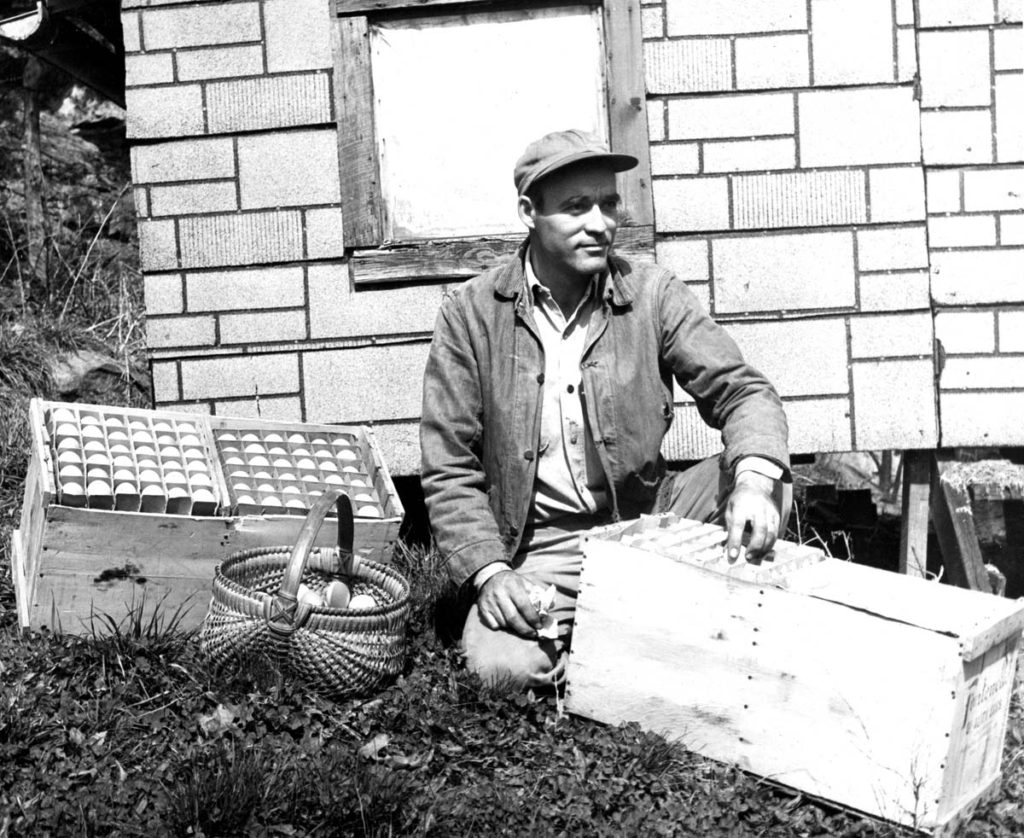Pine Mountain Settlement School
Series 02: GOVERNANCE – Board of Trustees
Series 09: BIOGRAPHY – Staff, Students
William Hayes
Native American Collection

William Hayes in poultry yard. [VII 64_life_work_002.jpg]
TAGS: William Hayes Native American Collection, Native Americans, Indians, pottery, flints, axes, artifacts, Kentucky counties, farming, petroglyphs
WILLIAM HAYES Native American Collection
Student, September 1934 – May 1938
Farm Manager, 1937 – 1953
Member, PMSS Board of Trustees, 1980s and 1990s
The William Hayes Native American Collection, gathered and donated to Pine Mountain Settlement School by William Hayes, forms part of the Environmental Education program and is held in Boy’s House (Library). It is comprised of materials gathered while Hayes was the Farm Manager at Pine Mountain (1938-1953). The collection consists of flints, potsherds, amulets and other objects from the tilled fields of the School.
Also included in the William Hayes Native American Collection at Pine Mountain Settlement School are objects gathered from his early childhood in McCreary County, Kentucky, and in Harlan County, Kentucky, and from his later work as a reclamation supervisor on mountain-top removal sites in Kentucky. Many Native American cliff dwellings, petroglyphs, and other artifacts* of the region’s Native American populations were disturbed, obliterated, and buried by the activity of surface mining in the region. Hayes was able to salvage a handful of evidence and artifacts before legal action could be initiated to stop their destruction. The surface mining artifacts represent only a small percentage of the objects lost in the heavy mining activity of the 1970s and succeeding years.
Hayes compiled a partial list of the most significant items when they were loaned to the Bobby Davis Museum, in Hazard, Kentucky. His Museum collection was removed at the request of Hayes shortly before his death, to be housed at Pine Mountain as part of the Environmental Program study collection. This list is not comprehensive in its accounting of the Hayes Collection now held at Pine Mountain, as some items were donated before the Hazard museum items and other items were later donated to the collection.
The original Hazard Bobby Davis Museum list of items as described by Hayes is given below:
*NOTE: An artifact or artefact (from Latin phrase arte factum~ars skill + facere to make) is “something made or given shape by man, such as a tool or a work of art, esp an object of archaeological interest”.[1] “Artifact” is the only spelling in American English, whilst “artefact” is generally preferred elsewhere[2] (see spelling differences). [WIKIPEDIA]
- ANIMAL BONES: Animal bones were found near the prehistoric midden (refuse heap) on Hall Mountain in Perry County, Kentucky. The animals could be bear, deer, turkey, raccoon, squirrel or ground hog.
- ABRASIVE SANDSTONE ROCKS OR TOOLS: This collection came from under one rock overhang in Breathitt County, Kentucky, measuring some 30 feet in width by 14 feet high. The cliff outcrop was just under the ridge top near the head of Spicewood Branch on the South Fork of Quicksand Creek. On this cracked sandstone (one of several under this cliff overhang) there are some smaller round holes that could have been used for cracking walnuts and hickory nuts for food. Along with the rocks were several pieces of potshards from which the upper half of a large pot was put together. Very few projectile points and other flint artifacts were found on this spot.
- AXE: This huge axe, with the lower part missing, came from a field in Powell County, Kentucky. Since the area where the axe was found had been under cultivation for many years, the long scratches were made by a disk harrow passing over the axe many times.
- CELT: This “celt,” often called a “tomahawk,” axe was the largest axe in this collection. It came from Wallins Creek, Kentucky, in Harlan County.
- SHERDS: These sherds came from below Putney Tower [Harlan County, Kentucky], two miles west of Pine Mountain Settlement School on the right side of the ridge going down the south side of the Pine Mountain.
- GORGETS: These are small breast plates worn suspended from the neck as an adornment or insignia of rank [often] by a medicine man or clan leader. Some gorgets were made from discarded potsherds; these pieces are shale. The larger piece of gorget came from the Sand Cave area on the Little Shepherd Trail between Highway 421 and Highway 160, three miles east of Pine Mountain Settlement School on the south side of Pine Mountain in Letcher County, Kentucky. Corn cobs were found under a very dry overhang on the south side of Pine Mountain close to Sand Cave area. Small patches of corn must have been raised where timber had been killed by debarking the trees and letting in the sunlight.
- FLINT: This flint came from a ridge northeast of Jackson in Breathitt County, Kentucky, called Flint Ridge. This ridge was destroyed by strip mining. It was located northeast of Jackson close to the headwaters of the Right Fork of Quicksand.
- SPEAR POINT: The finest crafted spear point in the collection was found in McCreary County, Kentucky.
- FAULKNER ARTIFACTS: One group of artifacts now belonging to the Hayes Collection came from James Faulkner, a former Pine Mountain Settlement School worker, who, along with his wife, worked at the School in the early 1930s. The objects were found on Greasy Creek — one of the headwaters of the North Fork of the Kentucky River [Harlan County, Kentucky]. It is thought that at this spot — a large field below a cave — there was an Indian encampment. Many arrowheads were made there and that explains the many half-finished ones.
See Also:
WILLIAM HAYES (Part I) Biography

